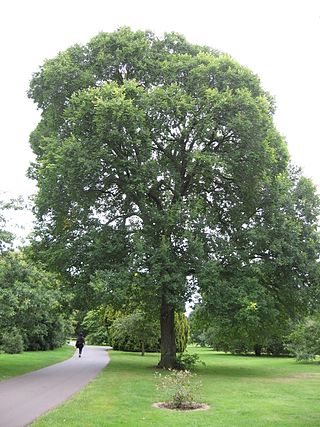Top Qs
Timeline
Chat
Perspective
Ulmus 'Karagatch'
Elm cultivar From Wikipedia, the free encyclopedia
Remove ads
Ulmus 'Karagatch' is a hybrid cultivar from Turkestan (from a region now part of Turkmenistan), selected in the early 20th century and considered either a backcrossing of U. × androssowii and U. pumila, or simply a cultivar of × androssowii. It was grown from seeds, introduced from Bairam Ali in Russian Turkestan by Arthur P. Davis in the 1930s, as U. 'Karagatch', under which name it was planted at Kew.[1][2]
Remove ads
Description
The Kew specimen had the appearance of a northern European field elm, more tall than broad.[1] 'Karagatch' was described by the US Department of Agriculture (1917) as a "rapid-growing elm", suitable for semi-arid regions, with harder wood than that of American Elm.[2]
- 'Karagatch' at Kew Gardens, 1990[3]
Pests and diseases
No information available.
Cultivation
'Karagatch' was present at Kew and in The Hague from the early 1930s.[3] The Kew specimen was felled in 2015 as 'unsafe'. It was cloned and remains in cultivation (see 'Accessions').
Etymology
The name 'karagatch' (:'black tree' in the Turkic languages, widely used for 'elm') has historically also been applied to U. minor 'Umbraculifera' (syn. U. densa) from the same region , and more loosely to field elm found in Turkey and to U. pumila found in Mongolia.[4]
Accessions
North America
- Morton Arboretum, US. As Ulmus × androssowii × U. pumila hybrid. Acc. no. 353–72
Europe
- Grange Farm Arboretum, Lincolnshire, UK. Acc. details not known.
- Wijdemeren City Council, Netherlands. Elm collection, ‘s-Gravelandsevaartweg, Loosdrecht, five trees planted 2016
References
Wikiwand - on
Seamless Wikipedia browsing. On steroids.
Remove ads


